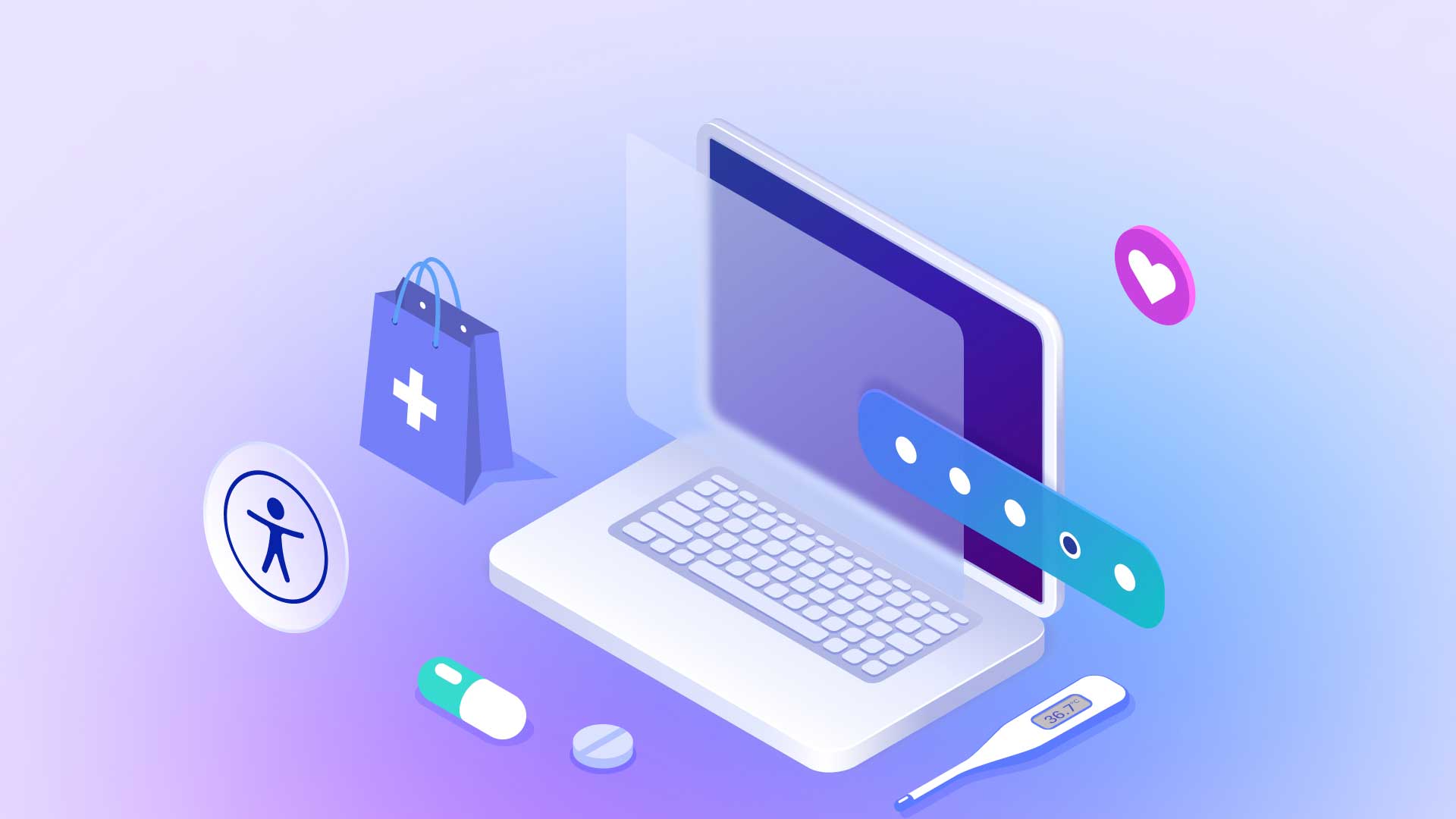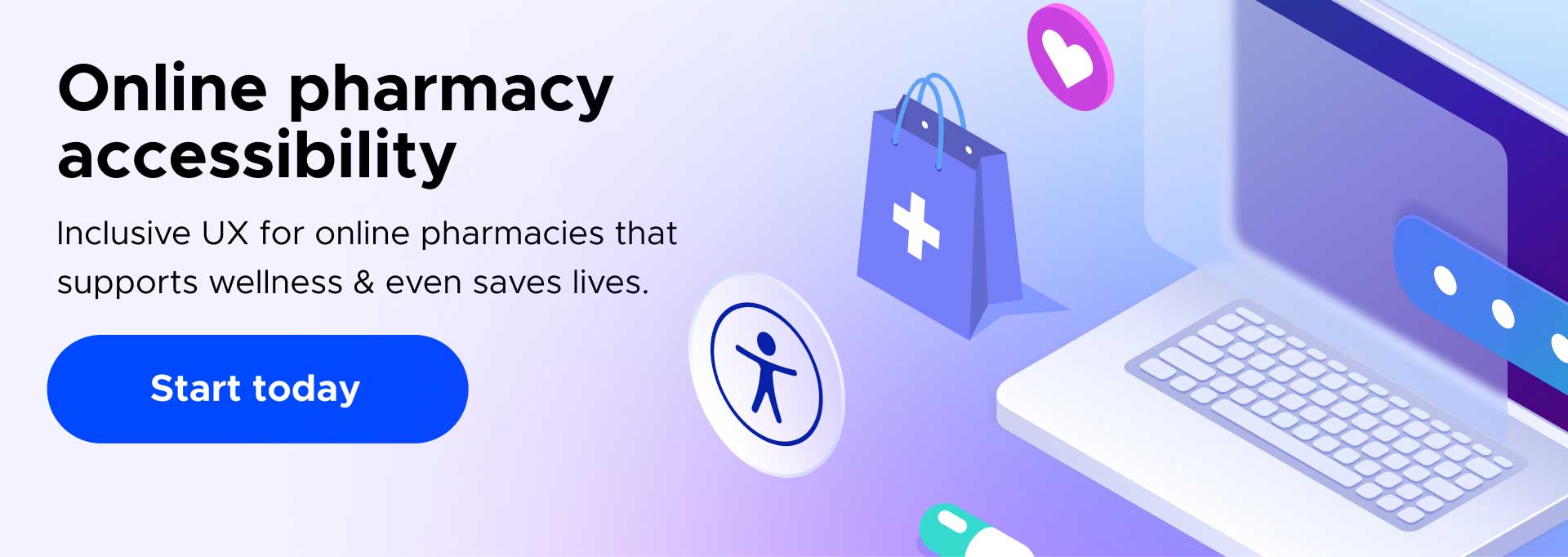Online Pharmacies: A Literal Lifeline for Some With Disabilities

As digital technology advances at a dizzying pace, more consumers choose to get healthcare information and buy their medication online. And for people with particular mobility, cognitive, and vision-related disabilities, online pharmacies may be the only option to get these critical meds. For instance, some people can’t perform daily errands independently or see well enough, even with the help of eyeglasses. And unfortunately, like most industries, this one is still far behind the digital inclusivity curve—97% of all websites worldwide remain inaccessible to people with various disabilities.
Think about that for a second. What if you couldn’t buy the meds online that keep you alive or help you live everyday life? That’s what an inaccessible online pharmacy can mean for some with various disabilities.
This blog offers best practices for producing an accessible online pharmacy and covers legal requirements. But first, let’s learn about the growing popularity of online pharmacies and how their inaccessibility can negatively impact people with disabilities.
The Rise of Mail-Order Pharmacies
Most people still associate pharmacies with traditional retail outlets like CVS and Walgreens. Or maybe it’s a family-owned local pharmacy store where folks regularly drop off and pick up their prescriptions with little or no difficulty. It’s true that these bricks and mortar stores once dominated the retail space, but online pharmacies are now a real competitive threat. Also known as mail-order or digital pharmacies, online outlets have rapidly escalated out of convenience and necessity.
Online drugstores are an excellent choice for most people, especially those without disabilities or other mitigating factors. But considering most of these websites still lack digital accessibility, where does that leave people who can’t readily visit a physical location? For instance, interrupting regular drug use for seizures, anticoagulants, or psychiatric issues can be severe or life-threatening. And these are just a few examples illustrating the need to make the web more inclusive.
So, what about the legal risks associated with a digitally inaccessible online pharmacy? The following section does a deeper dive into the compliance requirements.
How Accessibility Laws Impact Online Drugstores
Start by familiarizing yourself with three primary laws: the Americans with Disabilities Act (ADA), The WCAG, and Section 1557 of the Affordable Care Act. See a summary of each below:
1. The Americans With Disabilities Act (ADA): Inaccessible websites can obstruct people from what they need, just like a sidewalk without a ramp impedes their access to a physical location. ADA Title II prohibits discrimination against people with disabilities in all state and local government services, programs, and activities. These organizations must ensure fair and equal communication for people with disabilities. Digital accessibility is a priority for the Department of Justice, which consistently rules that ADA requirements apply to all state and local government agencies.
2. WCAG 2.1: Known as the digital accessibility gold standard, following these international guidelines will help you improve your digital accessibility for websites, apps, and related devices.
3. WCAG 2.2: WCAG 2.2 includes everything in WCAG 2.1, so websites that comply with WCAG 2.2 also comply with 2.1. Like all WCAG updates, WCAG 2.2 improves and builds on its predecessors. Notably, it serves more vision, hearing, and mobility-related conditions on desktop, tablet, and mobile devices.
4. Section 1557: This regulation requires government-funded healthcare organizations to provide accessible digital resources and electronic communications, including:
- Access to an online appointment system.
- Accessible billing and statements.
- Comparison of health plans offered through a health insurance marketplace
- Plan and benefits information
- The Office for Civil Rights clarifies that all info and electronic tech falls under Section 1557
What are your next steps? Follow the five strategies below to increase online pharmacy accessibility.
5 Ways to Improve Accessibility for Digital Pharmacies
1. Know the Critical Accessibility Laws
Gain an intimate knowledge of accessibility standards like the WCAG to endure website inclusivity.
2. Hire People with Disabilities To Test Your Website
Who better to call out accessibility obstacles than people with disabilities? This approach gives you the best possible insights into their user experience. It also empowers your dev team to make the proper fixes before unveiling a product or service.
3. Use Assistive Technology
Assistive tech tools like screen readers make it easier for people with disabilities to access healthcare info and support.
4. Offer AAC Devices
Augmentative and Alternative Communication (AAC) devices are crucial for patients with verbal communication challenges. They help these patients clearly express their needs to providers, substantially improving their healthcare experience.
5. Provide Multiple Content Sources
Beyond website text, you should also provide audio and video recordings for people who have trouble reading or comprehending written content. Additionally, provide visual cues like diagrams and charts supported by descriptive text to ensure accessibility.
The Clock is Ticking for Online Pharmacy Accessibility
For some people, an accessible pharmacy is a lifeline or critical support system they can’t do without. A recent AHIMA Foundation survey found that end users with disabilities often face frustrating obstacles to digital content. Even worse, millions have extenuating circumstances like insufficient transportation access that prevent them from visiting physical locations.
All of this said, it’s critical to remember that every second counts for people with specific disabilities and medical conditions. Interrupting the use of some prescriptions can have serious, even life-threatening consequences. So now is the time to act, and thankfully the best assistive tech providers help make digital accessibility and compliance a quick and affordable solution.
Discover how UserWay can be your go-to source for web compliance and digital technology in healthcare.
UserWay: The Best Prescription for Digital Accessibility
If you’re a healthcare organization looking to improve digital accessibility and compliance, make UserWay your first and only choice. Take advantage of industry-leading, AI-powered accessibility tools, attorney-led legal support, and compliance-based partnership programs. Join organizations from every market worldwide that choose UserWay to improve online inclusivity and conform to critical accessibility laws.
Begin with one-on-one guidance for invaluable insights or a free trial to get the full scope of UserWay’s products and services. It’s your choice!
Answers to Common FAQs
Why Do Online Pharmacies Appeal to Most People?
Most people choose online pharmacies for convenience, accessibility, cost transparency, privacy, and availability.
What’s The Most Common Dispensing Error?
Dispensing the wrong drugs, inaccurate dosing, and distributing them to the wrong patients are the most common errors.
How Can Patients Know If Buying Medicines Online Is Safe?
Patients should verify that their online pharmacy is NABP-accredited and a Verified Internet Pharmacy Practice Site to avoid buying counterfeit meds. They should only buy prescription drugs online from websites with these accreditations.





Share